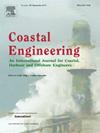Seamless nearshore topo-bathymetry reconstruction from lidar scanners: A Proof-of-Concept based on a dedicated field experiment at Duck, NC
IF 4.5
2区 工程技术
Q1 ENGINEERING, CIVIL
引用次数: 0
Abstract
Accurate observations of the nearshore bathymetry, including within the breaking wave region, are critical for the prediction of coastal hazards, and improved understanding of sandy beach morphological response to storms. In this paper, we implement the recent Boussinesq theory-based depth inversion methodology of Martins et al. (Geophys. Res. Lett., 50 (2023), Article e2022GL100498) to single- and multibeam lidar datasets collected during a dedicated field experiment on a sandy Atlantic Ocean beach near Duck, North Carolina. Compared with common approaches based on passive remote sensing technology (e.g., optical imagery), lidar scanners present several key advantages, including the capacity to directly measure the beach topography, waveforms and the cross-shore variations in mean water levels due to wave action (e.g., the wave setup), leading to the seamless reconstruction of a vertically-referenced beach topo-bathymetry. Given the potentially gappy nature of lidar data, particular attention is paid to the robust computation of surface elevation spectral and bispectral quantities, which are at the base of the proposed non-linear depth inversion methodology. Promising results on the final topo/bathymetry are obtained under contrasting wave conditions in terms of non-linearity and peak period, with an overall root-mean square error below 0.3 m obtained along a cross-shore transect covering both shoaling and breaking wave conditions. The accuracy of the final bathymetry in the shoaling and outer surf regions is generally found to be excellent, with similar skills as previously obtained in laboratory settings (relative error ). Under the most energetic conditions, an underestimation of the wave phase velocity spectra is observed within the surf zone with all theoretical frameworks, potentially owing to surf zone vortical motions not yet accounted for in the present methodology. This underestimation of the wave phase velocities results in a relatively large overestimation of the mean water depth, between 30% to 100% depending on the theoretical framework. With the methodology described herein, lidars bring new perspectives for seamlessly mapping the nearshore topo/bathymetry, and its temporal evolution across a wide range of scales. Although currently limited to a single cross-shore transect, we believe that opportunities exist to integrate multiple remote sensors, which could address individual sensor limitations, such as coverage (lidar) or the incapacity to directly measure waveforms (optical imagery).
来自激光雷达扫描仪的无缝近岸地形测深重建:基于北卡罗来纳州Duck专用现场实验的概念验证
近岸测深的准确观测,包括在破碎波区域内,对于海岸灾害的预测和提高对沙滩形态对风暴响应的理解至关重要。在本文中,我们实现了最近的基于Boussinesq理论的深度反演方法。卷。在北卡罗莱纳州Duck附近的大西洋沙滩上进行了一项专门的野外实验,对单波束和多波束激光雷达数据集进行了研究,50 (2023),Article e2022GL100498。与基于被动遥感技术(如光学成像)的常见方法相比,激光雷达扫描仪具有几个关键优势,包括能够直接测量海滩地形、波形和由于波浪作用(如波浪设置)导致的平均水位的跨海岸变化,从而实现垂直参考海滩地形测深的无缝重建。鉴于激光雷达数据的潜在缺陷,我们特别关注地表高程谱和双谱量的鲁棒计算,这是所提出的非线性深度反演方法的基础。在非线性和峰值周期的对比波浪条件下,在最终的地形/水深测量中获得了令人鼓舞的结果,在覆盖浅滩和破浪条件的跨岸样带上获得了总体均方根误差小于0.3 m的结果。在浅滩和外冲浪区域的最终测深精度通常被认为是优秀的,与之前在实验室环境中获得的技能相似(相对误差<;10 - 15%)。在最具能量的条件下,在所有理论框架下,在冲浪带内观察到波相速度谱的低估,可能是由于目前的方法尚未考虑到冲浪带的涡旋运动。这种对波相速度的低估导致了对平均水深的相对较大的高估,根据理论框架的不同,在30%到100%之间。通过本文描述的方法,激光雷达为无缝绘制近岸地形/水深及其在大范围内的时间演变带来了新的视角。虽然目前仅限于单一的跨海岸样带,但我们认为存在整合多个远程传感器的机会,这可以解决单个传感器的限制,例如覆盖范围(激光雷达)或无法直接测量波形(光学图像)。
本文章由计算机程序翻译,如有差异,请以英文原文为准。
求助全文
约1分钟内获得全文
求助全文
来源期刊

Coastal Engineering
工程技术-工程:大洋
CiteScore
9.20
自引率
13.60%
发文量
0
审稿时长
3.5 months
期刊介绍:
Coastal Engineering is an international medium for coastal engineers and scientists. Combining practical applications with modern technological and scientific approaches, such as mathematical and numerical modelling, laboratory and field observations and experiments, it publishes fundamental studies as well as case studies on the following aspects of coastal, harbour and offshore engineering: waves, currents and sediment transport; coastal, estuarine and offshore morphology; technical and functional design of coastal and harbour structures; morphological and environmental impact of coastal, harbour and offshore structures.
 求助内容:
求助内容: 应助结果提醒方式:
应助结果提醒方式:


